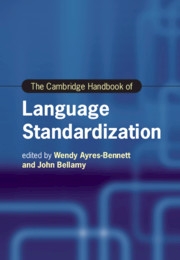Book contents
- The Cambridge Handbook of Language Standardization
- cambridge handbooks in language and linguistics
- The Cambridge Handbook of Language Standardization
- Copyright page
- Contents
- Figures
- Tables
- Contributors
- Introduction
- Part I Revisiting Models and Theories of Language Standardization
- Part II Legitimacy, Authority and the Written Form
- Part III Norms, Literacy and Education
- Part IV Beyond the National
- 19 Transnational Standards of Languages
- 20 Standardization across State Boundaries
- 21 Language Modernization in the Chinese Character Cultural Sphere
- 22 Linguistic Norms, Centre–Periphery Dynamics and the Tension between Uniformity and Diversity in Processes of Standardization
- 23 When Ethnic Boundaries and Language Boundaries Mismatch
- 24 The Standardization of a Stateless Language
- Part V Standardization in Late Modernity
- Name Index
- Subject Index
- References
21 - Language Modernization in the Chinese Character Cultural Sphere
China, Japan, Korea and Vietnam
from Part IV - Beyond the National
Published online by Cambridge University Press: 01 July 2021
- The Cambridge Handbook of Language Standardization
- cambridge handbooks in language and linguistics
- The Cambridge Handbook of Language Standardization
- Copyright page
- Contents
- Figures
- Tables
- Contributors
- Introduction
- Part I Revisiting Models and Theories of Language Standardization
- Part II Legitimacy, Authority and the Written Form
- Part III Norms, Literacy and Education
- Part IV Beyond the National
- 19 Transnational Standards of Languages
- 20 Standardization across State Boundaries
- 21 Language Modernization in the Chinese Character Cultural Sphere
- 22 Linguistic Norms, Centre–Periphery Dynamics and the Tension between Uniformity and Diversity in Processes of Standardization
- 23 When Ethnic Boundaries and Language Boundaries Mismatch
- 24 The Standardization of a Stateless Language
- Part V Standardization in Late Modernity
- Name Index
- Subject Index
- References
Summary
This chapter delineates lexical modernization in four states (Japan, China, Korea, Vietnam) where the writing system allowed for modernization and standardization to evolve transculturally. Japan, as the first ever non-Western country to modernize, served in many aspects as a model for how terminological gaps could be filled in the wake of modernization in East Asia. Script played a crucial role therein. Chinese characters have historically been used in all four polities discussed here, and what is more, this script allows for an easy spread of newly coined works due to its morpho-semantic character. The fact that these written terms can then be read differently in each of these four polities also allows these graphic loanwords to appear as original to the language in which they are used. The spread of Sino-Japanese modern terminology in East Asia via Chinese script characters shows that script has repercussions on language modernization. This pleremic script system serves as a transcultural and transnational resource.
Keywords
Information
- Type
- Chapter
- Information
- The Cambridge Handbook of Language Standardization , pp. 576 - 596Publisher: Cambridge University PressPrint publication year: 2021
References
Accessibility standard: Unknown
Why this information is here
This section outlines the accessibility features of this content - including support for screen readers, full keyboard navigation and high-contrast display options. This may not be relevant for you.Accessibility Information
- 3
- Cited by
